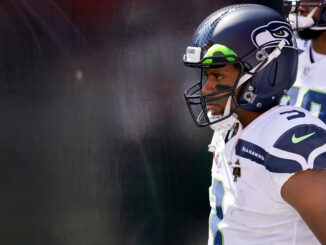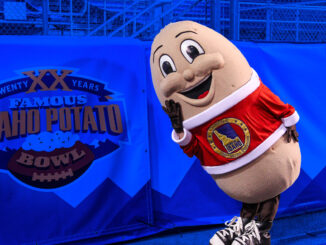
BIG GAME: The NFL in Dangerous Times
By Mark Leibovich
Penguin Press. 373 pp. $28
With the midterm elections around the corner, Brett Kavanaugh’s contentious confirmation barely in the rear view mirror, and football season in full swing, it seemed like a good time to pick up the latest book from Mark Leibovich, chief national correspondent of The New York Times Magazine and acclaimed author of This Town (Penguin 2013), which offered a zestful, inside look at some of the arrestingly vain political personalities that make Washington tick.
In Big Game: The NFL in Dangerous Times, Leibovich takes his talents to the gridiron, attending owner’s meetings, super bowls, draft nights, Hall of Fame events, and other football-related gatherings over a four year period from mid-2014 to January 2018.
Big Game spawned from a profile piece Leibovich wrote on New England Patriots quarterback Tom Brady in January 2015, just before Brady won the fourth of his five Super Bowl rings. Leibovich, transparently, is a Patriots fan (having grown up in the suburbs of Boston) and Big Game devotes much of its attention to Leibovich’s interactions with Brady, Patriots owner Robert Kraft, and head coach coach Bill Belichick.
In regards to Brady, Leibovich is most interested in his disciplined lifestyle and entrepreneurial pursuits (including the TB12 Method, Brady’s patented holistic lifestyle focused primarily on pliability and pre-hab (“not just a training regimen”)). While Brady’s persistent excellence and purposefully middle-of-the-road personality bore most anyone outside the greater New England area, the inside access granted to Leibovich paints an intriguing picture of someone obsessed with conquering time, who is absolutely faithful to the strictest of dietary and lifestyle regiments. Brady sleeps in patented biometric sleepwear, for instance: “If my opponents aren’t wearing what I wear, I’m getting the edge on them even while I’m sleeping.”
Leibovich explores Brady’s relationship with his personal lifestyle guru, Alex Guerrero, and despite Leibovich’s admittedly biased fan attraction to Brady, his interviews with Brady’s parents and Brady’s willingness to, for whatever reason, allow Leibovich into his life are revelatory. If Brady is representative of something larger than himself, as, perhaps, the greatest player to ever play American football, and what it takes to become that, Leibovich’s exposés on Brady, both in Big Game and elsewhere, can be thought of as fascinating anthropological diggings.
Brady, however, isn’t the only subject of Big Game. In fact, most of the book is taken up with NFL owners. Leibovich has a knack for securing interviews with figures otherwise reticent to give them, and the owners, players and executives seem to appreciate Leibovich’s genuine interest in whatever they want to talk about (even if Leibovich chides them many months later in his book!). Of course, Leibovich probably wouldn’t write a book about not being able to interview these people, but the tone throughout Big Game is convivial and more than once I found myself laughing out loud while reading (as many reviewers similarly noted while reading This Town).
Likewise, Leibovich’s political talents are suited here. One realizes fairly quickly the NFL owners Leibovich mingles with are, at their base, politicians. Old, white, male, billionaire politicians (for the most part). Leibovich has no trouble poking fun at them, while simultaneously luring them in to confide in him in unexpected ways. Though not one owner comes off as even remotely relatable to the millions of everyday citizens who obsessively watch the NFL (filtering their hard earned money up the food chain to these megalomaniacs), Leibovich somehow turns them into beings that are human (even while the owners continually attempt to outdo each other for numero uno prima donna status).
The most telling episode occurs when Jerry Jones, owner of the Dallas Cowboys, invites Leibovich into the Cowboys’ bus, and after a few 24oz – yes 24oz – plastic Cowboy cups of Johnnie Walker Blue ($250 a bottle), on the rocks, filled to the top, Jones admits to masturbating into shoes he once sold as a youth. (As a young man, Jones said he did a stint as a shoe salesman, which he also loved). He then said something about “spending the afternoon masturbating over selling shoes.”
Wait, WHAT?
“I’ve sold shoes,” Jones said again, “and I’ve masturbated in my shoes.”
Sounds like some sort of fetish you’d see on TubeV Sex to me. While Jones and Leibovich are beyond inebriated at this point (around 4pm), distilling the aura of this arrogant, billionaire petroleum tycoon into an insecure youth who masturbates into shoes is no small feat (no pun intended). To anyone who has ever grimaced at Jones’ bigger than life personality, the tale is blessedly welcome.
Alongside the infatuation with Brady-and the owners in general-Leibovich’s main points of investigation revolve around 1) Roger Goodell, the oft-maligned NFL commissioner, and 2) the recent unavoidable intersections of the NFL and politics, namely the NFL’s full-bore attempt to silence voices around the permanent brain damage inflicted on NFL players, and the NFL’s mafia-like attitude toward player protests that began with Colin Kaepernick and have carried on into the presidency of Donald Trump.
In addition, if somewhat tangentially, Leibovich also writes warmly about his father (who passed away just after Super Bowl LI), his younger brother (who passed away unexpectedly in a car crash), an artist friend who takes him to a Patriots game, the love he receives at ice cold Lambeau field, and the plethora of reporters who make a bountiful living finding nugget after nugget of NFL transactional information, feeding the tweet-boxes of passionate fantasy football players across the globe.
The bulk of the book, however, revolves around the higher-ups. Goodell, the highest of the higher-ups, is painted mainly as a yes-man for the owners, but a tough-guy yes-man who is willing to stand up to certain owners (even Jerry Jones) when it’s politically solvent to do so for the other owners. Goodell’s $40 million salary is shocking even to Leibovich, and he digs deep into how this inflated figure came about and why the owners have continually supported Goodell despite the unabashed negative attention he receives from the massive NFL fan base. (Spoiler: Goodell makes them all richer!) Goodell’s caricature as someone who constantly talks about how much he works out, and Leibovich’s descriptions of Goodell’s abnormally engorged pectoral muscles, provide more humorous fodder, while Leibovich’s discussions with Goodell’s wife are entertaining and revealing.
While the subtitle of the book is somewhat misleading – it led me to think the entire focus of the book would be on the abundance of CTE (Chronic Traumatic Encephalopathy: a degenerative brain disease caused by repetitive head trauma) found in former NFL players, often ones that suffered ignominious fates (CTE can only be diagnosed posthumously) – Leibovich does make it an on-again off-again thread that offsets nicely the persistent cartoon-like humor Leibovich finds in the personalities of the billionaires. The depictions of former players he meets while attending Hall of Fame events are unnerving and shocking. Likewise, when pushed on the subject, it’s clear the NFL talking heads are trained to highlight how much safer the game has become, and how much the NFL is currently doing, rather than admit the blatantly obvious connection, at this point, between CTE and a life devoted to playing in the NFL.
Likewise, Leibovich points to player interviews being cut short when they are speaking on the matter, and a blanket gag order on the higher ups to ever acknowledge the 2015 movie Concussion, starring Will Smith!
This top-down mandate model transcends into the NFL’s other great consternation of late – players using their platform as athlete celebrities to protest the injustices and unlawful killings of African Americans by police officers across the United States. Leibovich brings to light a not-often talked about summit, between owners, players, and executives, in which the respective groups simply talk over each other. Terry Pegula, the owner of the Buffalo Bills, goes so far as to suggest that what the NFL needs is a Charleton Heston-type figure, much like the NRA employed for years, to be their spokesperson – a black Charleton Heston however: “‘For us to have a face, as an African American that could be in the media,’ Pegula said, ‘we could fall in behind that.'”
The players, namely Eric Reid, continually ask them why Kaepernick (who began the protests) doesn’t have a job, and the owners won’t answer. The sheer unwillingness of the owners to acknowledge their players’ concerns and First Amendment rights as citizens is galling, and the fact they suggest hiring a black spokesperson, while a successful NFL quarterback remains off all rosters, is unconscionable. Leibovich is attuned to this. Of course, none of these billionaires became billionaires by advocating for civil rights and fair play, but the examples, nevertheless, remain shocking, and one wonders what off-the-record comments would further emerge from the likes of say, Bob McNair, the owner of the Houston Texans, who famously proclaimed “we can’t have the inmates running the asylum.”
Which brings Leibovich to Donald Trump. Trump, the one-time owner of the USFL New Jersey Generals, who pined and pined to get into the NFL as an owner for years, only to be repudiated again and again, while simultaneously driving the USFL into oblivion. Jeff Pearlman, author of a newly released book on the USFL, claims then Commissioner Pete Rozelle, along with the other owners, viewed him as a “scumbag huckster … a fast-talking, kind of con man.”
Essentially, they never took Trump’s inquiries seriously because these actual billionaires, many of them self-made, could see past the con-man façade that Trump emanates. The commissioner, none of the owners, felt he could deliver.
This, of course, resonates deeply with the way many of us felt prior to the 2016 election, political leanings aside. How could this person possibly become our president? And then, remarkably, he did (though only if you consider the electoral college a worthwhile enterprise, which you probably do, if you are a rich, white Republican, having kept you in power 12 of the last 20 years, despite having won the popular vote only once!)
Leibovich’s insights into Trump’s rise to power and his dealings with the NFL owners are insightful and show another side of the unremitting vanity Trump suffers from. Trump, quite simply, has hammered the NFL since taking office, largely due to the NFL’s unwillingness to ever accept him. Leibovich delineates how Trump, fascinatingly, has managed to turn up a whole new slew of NFL detractors: from the original liberal-minded thinkers bemoaning the savage, war-like aspects of the game alongside the irreversible health effects inflicted on its players, to these new flag-waving conservatives crying out against unpatriotic athletes who should keep their mouths shut (black athletes, mind you) and just play the game.
Leibovich’s years of political writing clearly comes into play here, and while the book is meant to be entertaining more than anything, I found the political and social commentary as integral as the humor. It’s impossible to look past the multi-billion dollar industry the NFL currently is, and the structure of that industry, the persons and personalities that benefit the most, the inevitable oppression and racial divides the NFL brings to light, are impossible to ignore. It is hard to justify watching football after reading Leibovich’s book, in fact, but of course we, as a nation, will continue to do so.
And that, perhaps, is the most interesting nugget of all.




